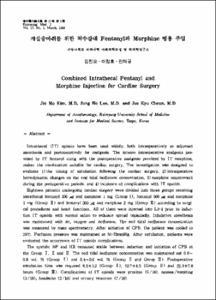개심술마취를 위한 척수강내 Fentanyl과 Morphine병용 주입
- Alternative Author(s)
- Kim, Jin Mo; Cheun, Jae Kyu
- Journal Title
- Keimyung Medical Journal
- Issued Date
- 1998
- Keyword
- Cardiac Surgery; Fentanyl; Morphine; Intrathecal
- Abstract
- Intrathecal (IT) opioids have been used widely, both intraoperatively as adjuvant anesthesia and postoperatively for analgesia. The intense intraoperative analgesia provided by IT fentanyl along with the postoperative analgesia provided by IT morphine, makes the combination suitable for cardiac surgery. The investigation was designed to evaluate 1) the timing of extubation following the cardiac surgery, 2) intraoperative hemodynamic changes on the end tidal isoflurane concentration, 3) morphine requirement during the postoperative periods, and 4) incidence of complications with IT opioids.
Eighteen patients undergoing cardiac surgery were divided into three groups receiving intrathecal fentanyl 200㎍ and morphine 1 mg (Grouop I), fentanyl 300 ㎍ and morphine 1 mg (Grouop II) and fentanyl 300㎍ and morphine 2mg (Group III) according to surgical procedures and heart functions. All of them were injected into L3-4 prior to induction IT opioids with normal saline to enhance spread cephaladly. Inhalation anesthesia was maintained with air, oxygen and isoflurane. The end tidal isoflurane concentration was measured by mass spectrometry. After initiation of CPB, the patient was cooled to 28℃. Perfusion pressure was maintained at 50-70mmHg. After extubation, patients were evalusted the occurrence of IT opioids complications.
The systolic BP and HR remained stable between induction and initiation of CPB at the Group I, II and III. The end tidal isoflurane concentration was maintained oat 0.6~0.8 vol. % (Group I) and 0.4~0.6 vol. % (Group II and Group III). Postoperative extubation time was required 8.5±3.2 (Group I), 12.7±4.5 (Group II) and 22.3±7.8 hours (Group III). Complications of IT opioids were pruritus (5/18), nausea/vomiting (3/18), headache (2/18) and urinary retention (7/18).
The combination of IT fentanyl and morphine provided stable intraoperative hemodynamics group I, but postoperative demediate tracheal extubation did not allowed of normal ventricular and espiratory function due to due to respiratory depression related to IT opioids. Prolonged intubation was needed in Group III (AVR, MVR with Atrial fibrillation) due to undeslying cardiac disease. We could not determine the optimal dos-age of IT opioid in each group due to the different IT opioid dosages in the three groups. However, dosage of IT opioid in Group II (CABG, MVR with normal sinus rhythm) was found to be relatively suitable compared to the other groups. All patients required significantly less dosage of postoperative intravenous morphine. We observed no clinical evidence of a subarachnoid or epidural hematoma.
- Alternative Title
- Combined Intrathecal
Fentanyl and Morphine Injection for Cardiac Surgery
- Publisher
- Keimyung University School of Medicine
- Citation
- 김진모 et al. (1998). 개심술마취를 위한 척수강내 Fentanyl과 Morphine병용 주입. Keimyung Medical Journal, 17(1), 49–60.
- Type
- Article
Items in Repository are protected by copyright, with all rights reserved, unless otherwise indicated.
